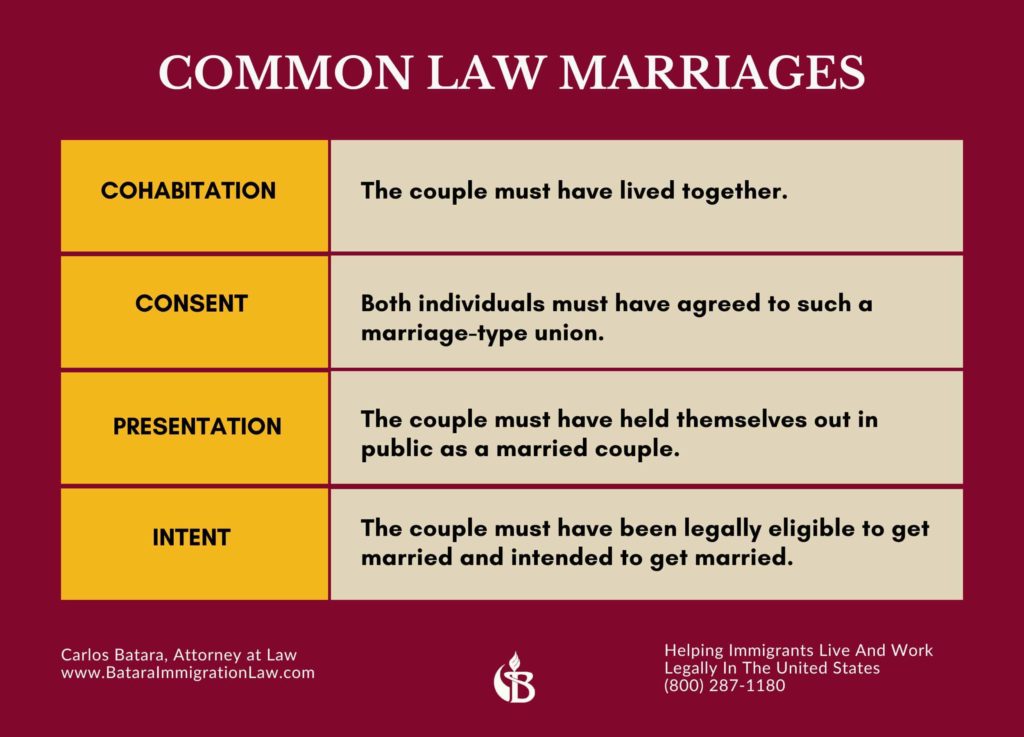
For many immigrants, common law marriages can unlock the door to green card success.
Yet, this is an area of law often missed by lawyers and non-lawyer representatives. As a result, immigrants who might have qualified for a grant of permanent residence end up with an order of deportation.
Here’s the reason for such errors.
Very few states in the U.S. recognize common law marriages.
However, immigrants (and their representatives) far too often overlook that the validity of a marriage is determined by the place where the marriage took place. This is known as the marriage “place of celebration”.
This could be another state, or even another country.
In other words, if you had a valid common law marriage in a state that recognizes them as legal – but you move to another state which does not acknowledge such marriages – the marriage remains valid in the second state.
- For instance, say you were married in Colorado. Colorado recognizes common law marriages.
- You move to California. California does not recognize common law marriages.
- But because your marriage was valid in Colorado, California will recognize it as valid.
Quirky, to say the least.
Common Law Marriages: An Uncommon Journey To Immigration Success
It means, first, that in a common law marriage state, a U.S. citizen or permanent resident could petition a common law spouse for green card status – so long as the common law marriage is valid.
Second, it means that even if the couple has moved to another state, a state which does not recognize common law marriages, the couple may still have a valid relationship for immigration purposes.
As a green card attorney, I’ve learned this is where the vast majority of mistakes are made in common law marriage cases.
Paralegals, notaries, and lawyers fail to study domestic partnership rules for places where immigrants lived previously.
To help avoid such miscues, let’s take a closer look at common law marriages and how they can benefit immigrants.
What Is A Common Law Marriage?
A common law marriage is one in which a couple lives together and holds themselves out to friends, family and the community as being married but never formalize the marriage.
Four Key Factors
There are four general requirements to prove such relationships in most common law states.

Cohabitation – The couple must have lived together. There is no minimum time required. Many folks believe that 7 years together is the magic number. They’re wrong.
Consent – Both individuals must have agreed to such a relationship. If one considers the relationship to be a marriage-type union, but the other person perceives it differently, then this requirement is not fulfilled.
Presentation – The couple must have held themselves out in public as a married couple, and their friends, family members, and acquaintances believed the couple was married.
This refers to actions like introducing each other with the same last name, or as “my wife” or “my husband”, in interactions with others, and signing official documents in a manner that indicated status as a married couple. This includes items like bank accounts, credit cards, rental agreements, and tax returns.
Intent – The couple must have been legally eligible to get married and intended to get married. Immigration officials will take a close look to ensure that prior divorces, if any exist, are final, and valid where they were issued.
In addition to the above, some common law states set more restrictive parameters, like a specific number of years spent in cohabitation, for domestic unions to qualify for common law marriages. It is the immigrant’s responsibility to show such conditions are satisfied.
USCIS officers will check to ensure that requirements for a common law marriage where it occurred were fully met. Their goal is to distinguish casual live-in arrangements from true common law relationships.
In addition, the government will assess if the marriage is not only legally valid but also one that is bona fide – not a sham or fraud to get a green card under false pretenses.
Be prepared to address such issues in all common law immigration cases.
What States Recognize
Common Law Marriages?
At present, only the following states recognize common law marriages: Colorado, Iowa, Kansas, Montana, New Hampshire, Oklahoma, and Texas. In addition, the District of Columbia recognizes common law marriages.
Immigrants and their representatives should not stop their inquiry into whether a common law marriage exists there.
They need to go a step further in their analysis of de facto marriages.
In the past, the number of states that previously recognized common law marriage was larger. If an immigrant was in a valid de facto marriage in such states during the period when common law marriages were valid there, he can still make a claim that his green card application remain valid today.
These states include Alabama, Florida, Georgia, Indiana, Ohio, Pennsylvania, Rhode Island, and South Carolina.
The Broad Reach Of Common Law Relationships On Immigrant Families
Common law relationships can have significant implications for immigrant families, besides just green cards for spouses through bona fide marriages. These situations include children of immigrants, step-parents, and domestically abused immigrants.
Permanent Residence For Common Law Immigrant Step-Children
In a common law marriage state, step-parents can petition step-children even if the biological immigrant parent and the U.S. citizen step-parent never formally married.
Assuming the common law marriage is valid, the key is the step-child’s age when the marriage to occurred. It must have taken place before the stepchild’s 18th birthday.
Thus, if a United States citizen and his domestic partner wife hold each other out as a married couple prior to her son’s 18th birthday, the U.S. citizen qualifies to sponsor his common law step-child for a green card.
Permanent Residence For Common Law Immigrant Step-Parents
On the other hand, the same is true in reverse, with a slight twist.
If a step-child is a United States citizen, and his mother has a common law spouse who lacks immigration documents, the step-child can petition his step-parent so long as the common law marriage happened before he turned 18.
However, there is an additional requirement.
The step-child must wait until he is 21. Immigration rules do not allow U.S. citizen children to file petitions for parents or step-parents before that age.
VAWA Benefits And Permanent Residence For Domestically Abused Common Law Immigrant Spouses And Children
Here’s another possibility that I have seen missed by immigration law practitioners.
Under the Violence Against Women Act, undocumented immigrant spouses (and their children) in an abusive marriage can seek protection and benefits.
Even though they are living in the U.S. without permission, VAWA may enable them to file a self-petition for green card status. To qualify, they must demonstrate they are, or have been, married to a U.S. citizen or permanent resident.
Once again, a valid immigrant common law marriage is sufficient to trigger an abused spouse’s right as a self-petitioner to seek permanent residence.
Of course, the burden of proof imposed on the immigrant spouse is again heightened. For not only a bona fide relationship with a U.S. citizen or permanent resident and a common law marriage, but also extreme cruelty or violence has to be shown.
Naturalization Through Common Law Permanent Residence
A fourth issue that I’ve seen arise out of common law marriages is whether they can also lead to citizenship.
Here, the USCIS Practice Manual is clear on the impact of common law marriages for purposes of naturalization.
According to USCIS, if a marriage was valid and recognized by the state where it took place, followed by a grant of permanent residence, filing for naturalization is allowed.
This is true even if the application for citizenship is filed in a state which does not recognize common law marriages.
Thus, like the permanent residence example given above, if an immigrant wins a green card based on a common law marriage in Colorado, there is no residency restriction on seeking citizenship.
In short, even if the immigrant subsequently moves to California, he or she can file for naturalization in California. .
In many cases, government officials will re-review the laws of the state where the common law marriage transpired to ensure it met all the state’s requirements for such marriages.
Immigrant Common Law Divorces
Generally speaking, there is no such thing as a common law divorce.
But if there is a valid common law marriage, then in order to be divorced, you must go through the normal family law divorce channels.
You must get a traditional divorce.
Otherwise, the common law relationship could backfire on you. If a partner to a common law union remarries without a divorce, he could be deemed guilty of bigamy – marriage to two different persons at the same time.
Take Silvester.
Silvester and ex-girlfriend lived in Uruguay. They lived together 3 ½ years. They broke up and Silvester moved to the United States. Shortly after moving to the U.S., he learned his ex-girl friend was pregnant. A few months later, a child was born.
He accepted responsibility. From time-to-time, when he visited Uruguay, he would visit his son. He paid an agreed amount of child support every month. He sent presents, gifts, and toys. Yet, the relationship with his ex-girl friend was never rekindled.
A few years later, he met a U.S. citizen and fell in love with her. She filed an I-130 petition to immigrate him. USCIS denied the petition. It asserted that Silvester had been involved in a common law marriage. Neither he nor his ex-girl friend had filed for a divorce. Thus, in the government’s view, Silvester was not eligible to remarry the U.S. spouse.
On appeal, Silvester found out Uruguay, a country that recognizes common law marriage, defined them as uninterrupted cohabitation lasting five years. Because his relationship had only lasted 3 1/2 years, he prevailed.
Had he lost, he would have been facing deportation charges based on bigamy, .
What Types Of Evidence Prove The Validity Of Immigrant Common Law Marriages?
Before closing, let’s briefly peek at a few factors that USCIS officers will typically consider in order to determine the validity of a common law marriage for immigration purposes:
- When and where did the relationship begin?
- When did you and your common law partner begin to live together? How long did you live together?
- What was the intent and understanding of you and your “spouse” about the nature of your relationship at the beginning of the cohabitation period?
- How did you and your common law companion introduce each other to neighbors, friends, co-workers, and family members?
- Did you sign legal documents, like bank accounts, checks, credit cards, loans, contracts, with the same last name?
- Did either of you purchase a life insurance policy describing one or the other as the beneficiary spouse?
- Did either of you name the other one as the beneficiary spouse of the other’s pension rights?
- Does the birth registration and school registration of your children show each of you with the same last name?
Ready to take a serious and honest look at the strengths and weaknesses of your immigration case? Let’s get started with a personalized strategy and planning session . . .




